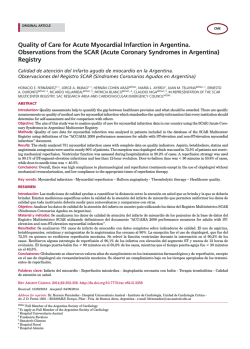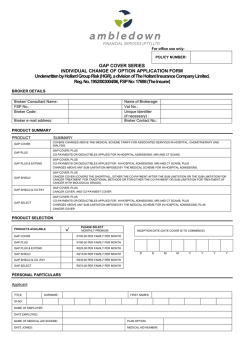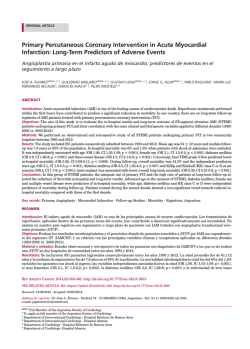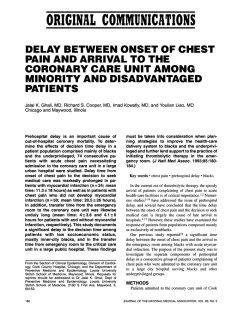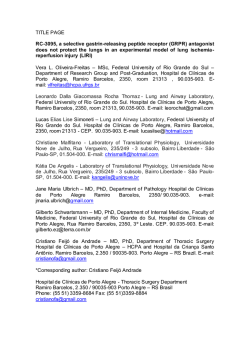
Utilization and Impact of Pre-Hospital Electrocardiograms for
Journal of the American College of Cardiology © 2009 by the American College of Cardiology Foundation Published by Elsevier Inc. Vol. 53, No. 2, 2009 ISSN 0735-1097/09/$36.00 doi:10.1016/j.jacc.2008.09.030 CLINICAL RESEARCH Myocardial Infarction Utilization and Impact of Pre-Hospital Electrocardiograms for Patients With Acute ST-Segment Elevation Myocardial Infarction Data From the NCDR (National Cardiovascular Data Registry) ACTION (Acute Coronary Treatment and Intervention Outcomes Network) Registry Deborah B. Diercks, MD, MSC,* Michael C. Kontos, MD,† Anita Y. Chen, MS,‡ Charles V. Pollack, JR, MD, MS,§ Stephen D. Wiviott, MD,ʈ John S. Rumsfeld, MD, PHD,¶ David J. Magid, MD, MPH,¶ W. Brian Gibler, MD,# Christopher P. Cannon, MD,** Eric D. Peterson, MD, MPH,‡ Matthew T. Roe, MD, MHS,‡ on behalf of the NCDR ACTION Registry Participants Sacramento, California; Richmond, Virginia; Durham, North Carolina; Philadelphia, Pennsylvania; Boston, Massachusetts; Denver, Colorado; and Cincinnati, Ohio Objectives This study sought to determine the association of pre-hospital electrocardiograms (ECGs) and the timing of reperfusion therapy for patients with ST-segment elevation myocardial infarction (STEMI). Background Pre-hospital ECGs have been recommended in the management of patients with chest pain transported by emergency medical services (EMS). Methods We evaluated patients with STEMI from the NCDR (National Cardiovascular Data Registry) ACTION (Acute Coronary Treatment and Intervention Outcomes Network) registry who were transported by EMS from January 1, 2007, through December 31, 2007. Patients were stratified by the use of pre-hospital ECGs, and timing of reperfusion therapy was compared between the 2 groups. Results A total of 7,098 of 12,097 patients (58.7%) utilized EMS, and 1,941 of these 7,098 EMS transport patients (27.4%) received a pre-hospital ECG. Among the EMS transport population, primary percutaneous coronary intervention was performed in 92.1% of patients with a pre-hospital ECG versus 86.3% with an in-hospital ECG, whereas fibrinolytic therapy was used in 4.6% versus 4.2% of patients. Median door-to-needle times for patients receiving fibrinolytic therapy (19 min vs. 29 min, p ϭ 0.003) and median door-to-balloon times for patients undergoing primary percutaneous coronary intervention (61 min vs. 75 min, p Ͻ 0.0001) were significantly shorter for patients with a pre-hospital ECG. A suggestive trend for a lower risk of in-hospital mortality was observed with pre-hospital ECG use (adjusted odds ratio: 0.80, 95% confidence interval: 0.63 to 1.01). Conclusions Only one-quarter of these patients transported by EMS receive a pre-hospital ECG. The use of a pre-hospital ECG was associated with a greater use of reperfusion therapy, faster reperfusion times, and a suggested trend for a lower risk of mortality. (J Am Coll Cardiol 2009;53:161–6) © 2009 by the American College of Cardiology Foundation The American College of Cardiology/American Heart Association ST-segment elevation myocardial infarction (STEMI) guidelines recommend prompt reperfusion with fibrinolytic agents within 30 min of hospital arrival (door-to-needle time [DTN]) or primary percutaneous coronary intervention (PCI) within 90 min of arrival (door-to-balloon time [DTB]) (1). However, contemporary analyses show that the majority of hospitals in the U.S. do not meet these benchmarks for the From the *University of California Davis Medical Center, Sacramento, California; †Virginia Commonwealth University Health System, Richmond, Virginia; ‡Duke Clinical Research Institute, Duke University Medical Center, Durham, North Carolina; §Pennsylvania Hospital, Philadelphia, Pennsylvania; ʈBrigham and Women’s Hospital, Boston, Massachusetts; ¶University of Colorado Medical Center, Denver, Colorado; #University of Cincinnati Hospital, Cincinnati, Ohio; and the **TIMI Study Group, Brigham and Women’s Hospital, Boston, Massachusetts. Manuscript received July 11, 2008; revised manuscript received September 10, 2008, accepted September 15, 2008. Downloaded From: http://content.onlinejacc.org/ on 02/06/2015 162 Diercks et al. Pre-Hospital ECG and Reperfusion timing reperfusion therapy (2). A recent consensus statement endorsed the use of pre-hospital elecCHF ؍congestive heart trocardiograms (ECGs) to rapidly failure diagnose and triage patients transDTB ؍door-to-balloon time ported by emergency medical serDTN ؍door-to-needle time vices (EMS) with a suspected ECG ؍electrocardiogram STEMI before hospital arrival (3). EMS ؍emergency medical Regional or municipal studies perservices formed within the last few years IQR ؍interquartile range have shown that the use of prePCI ؍percutaneous hospital ECGs was associated coronary intervention with shorter reperfusion times, and STEMI ؍ST-segment nationwide efforts have recently elevation myocardial been developed to increase the infarction availability of pre-hospital ECGs across the U.S. (4 –7). We therefore analyzed data from the NCDR (National Cardiovascular Data Registry) ACTION (Acute Coronary Treatment and Intervention Outcomes Network) registry to evaluate the nationwide utilization and impact of pre-hospital ECGs in a large cohort of patients with STEMI. Abbreviations and Acronyms Methods The NCDR ACTION registry and quality improvement program began January 1, 2007. As applicable at each site, data collected for this registry were either approved by an institutional review board or considered quality assurance data, and not subject to institutional review board approval. Patient inclusion criteria. Between January 1, 2007, and December 31, 2007, 271 ACTION hospitals enrolled 19,481 patients with STEMI (defined as persistent STsegment elevation or new left bundle branch block and presenting within 24 h of ischemic symptom onset). We excluded the following patients: those not evaluated first in the emergency department or the cardiac catheterization laboratory (n ϭ 2,575); patients transferred to an ACTION-participating hospital because the structure of the data collection form prevented delineation of location of the first ECG obtained (pre-hospital vs. in the outside hospital emergency department) (n ϭ 4,568); those with missing information on EMS transport (n ϭ 79); those with missing data on pre-hospital ECG (n ϭ 69); and those not listed as being transported by EMS, but who had a pre-hospital ECG recorded (n ϭ 93). The total initial analysis sample thus consisted of 12,097 patients with STEMI who directly presented to ACTION-participating hospitals either by self-transport or EMS transport. Data collection and accuracy. Data were abstracted by a trained data collector at each hospital. Variables collected included pre-hospital data, medical history, treatments administered, as well as associated major contraindications to evidence-based therapies, and in-hospital outcomes. Statistical analyses. Patients were initially categorized by whether or not they were transported by EMS. An Downloaded From: http://content.onlinejacc.org/ on 02/06/2015 JACC Vol. 53, No. 2, 2009 January 13, 2009:161–6 in-depth comparison was made among those patients with and without a pre-hospital ECG, after restricting the analysis cohort to only those transported by EMS. Demographic and clinical characteristics, reperfusion strategies, treatment patterns, and in-hospital outcomes were compared between patients with and without a pre-hospital ECG. Median values with interquartile ranges (IQRs) (25th, 75th percentile) were used to describe continuous variables, and numbers (percentages) were used for categorical variables. Patients were additionally classified regarding presenting during “on hours” (7 AM to 7 PM, Monday through Friday) or “off hours” (all other time periods), and by the time to the in-hospital ECG Յ10 or Ͼ10 min. To test for independence, prehospital ECG and baseline characteristics, in-hospital care patterns and outcomes, and the continuous and ordinal categorical variables were compared using stratum-adjusted Wilcoxon rank-sum tests, whereas nominal categorical variables were compared using stratum adjusted chi-square tests, for which stratification is by hospital. We evaluated 2 process-of-care measures: time from door to reperfusion treatment with either fibrinolytic agents or primary PCI. In examining the association between pre-hospital ECG and time to reperfusion, we used the generalized estimating equations method to account for within-hospital clustering. Variables entered into the model are based on known clinical predictors of outcome. Furthermore, the relationship between inhospital outcomes and pre-hospital ECG was explored using the logistic generalized estimating equations method adjusting for patient baseline characteristics only. Because DTB and DTN times were skewed, a logtransformation of these times was applied to normalize the distribution. When a dependent variable of a regression analysis has been transformed, the estimated coefficients must also be transformed to be interpreted appropriately (8). All analyses were performed using SAS software (version 9.1, SAS Institute, Cary, North Carolina). Results Clinical characteristics and treatment. A total of 7,098 of 12,097 patients (58.7%) included were transported to the ACTION-participating hospital by EMS. Patients transported by EMS were older; were less commonly male; more commonly had prior myocardial infarction (MI), prior congestive heart failure (CHF), and signs of CHF on presentation; and had shorter times from symptom onset to hospital presentation compared with patients who were self-transported to the ACTIONparticipating hospital (Table 1). Among the 7,098 patients transported by EMS, 1,941 (24.7%) received a pre-hospital ECG. Patients with a pre-hospital ECG were more commonly male, and less commonly had diabetes and left bundle branch block or signs of CHF on Diercks et al. Pre-Hospital ECG and Reperfusion JACC Vol. 53, No. 2, 2009 January 13, 2009:161–6 163 Clinical Characteristics: EMS Transport Versus No EMS Transport Table 1 Clinical Characteristics: EMS Transport Versus No EMS Transport Variable Overall (N ؍12,097) EMS Transport (n ؍7,098) 61 (52, 72) 62 (52, 75) No EMS Transport (n ؍4,999) p Value Demographics Age (yrs)* 59 (51, 69) Ͻ0.0001 Male 68.4 65.9 72.0 Ͻ0.0001 Caucasian 83.4 84.1 82.4 Ͻ0.0001 HMO/private 57.7 55.5 61.0 Medicare Insurance status 0.0001 23.8 26.4 20.2 Military/VAMC 1.1 1.2 1.1 Medicaid 3.6 3.8 3.5 Self/none 13.0 12.8 13.2 0.7 0.4 1.1 Hypertension 60.5 61.8 58.6 Diabetes mellitus 22.6 23.0 22.0 0.05 5.9 6.7 4.6 Ͻ0.0001 0.85 Missing Medical history Peripheral arterial disease 0.0001 Current/recent smoker 40.4 40.6 40.1 Dyslipidemia 46.4 47.2 45.3 0.30 Prior MI 19.2 20.8 16.9 Ͻ0.0001 Prior PCI Ͻ0.0001 19.0 20.2 17.3 Prior CABG 7.5 7.7 7.1 0.17 Prior CHF 5.9 7.2 4.0 Ͻ0.0001 Prior stroke 5.8 7.0 4.0 Ͻ0.0001 Dialysis use 0.9 1.0 0.8 0.68 Presentation features Symptom onset to hospital arrival (h)* Systolic blood pressure (mm Hg)* Heart rate (beats/min)* Signs of CHF 1.7 (1.0, 3.6) 1.5 (1.0, 2.9) 2.0 (1.0, 4.9) Ͻ0.0001 138 (117, 158) 131 (112, 150) 148 (127, 167) Ͻ0.0001 78 (65, 93) 77 (64, 93) 80 (67, 94) Ͻ0.0001 13.6 16.5 9.5 95.1 95.2 95.1 4.9 4.8 4.9 ECG findings Persistent ST-segment elevation New LBBB Ͻ0.0001 0.60 Data are expressed as percentages except where indicated. *Expressed as medians (25th, 75th percentiles). CABG ϭ coronary artery bypass graft; CHF ϭ congestive heart failure; ECG ϭ electrocardiogram; EMS ϭ emergency medical services; HMO ϭ health maintenance organization; LBBB ϭ left bundle branch block; MI ϭ myocardial infarction; PCI ϭ percutaneous coronary intervention; VAMC ϭ Veteran Affairs Medical Center. presentation compared with patients with an in-hospital ECG. The time from symptom onset to hospital presentation was similar between the groups (Table 2). Use of reperfusion therapy and acute medications by pre-hospital ECG use. Patients with a pre-hospital ECG were more likely to undergo primary PCI and less likely to receive no reperfusion therapy compared with patients with an in-hospital ECG (Table 3). Patients with a pre-hospital ECG were more likely to receive aspirin, clopidogrel, and glycoprotein IIb/IIIa inhibitors within the first 24 h (Table 4). Timing of reperfusion therapy. Among patients receiving reperfusion therapy, DTN and DTB times were faster in those with a pre-hospital ECG (Table 5). This difference persisted when stratified analysis were performed by “off-hours” versus “on-hours” presentation and by time to the in-hospital ECG (Յ10 min or not). These differences in DTN and DTB times persisted after adjusting for confounders. Patients who had a pre- Downloaded From: http://content.onlinejacc.org/ on 02/06/2015 hospital ECG had faster DTN times (adjusted decrease of 24.9%, 95% confidence interval: Ϫ38.1% to Ϫ9.0%) and faster DTB times (adjusted decrease of 19.3%, 95% confidence interval: Ϫ23.3% to Ϫ15.2%) compared with patients with an in-hospital ECG. In-hospital clinical outcomes. Among the overall EMS transport population, pre-hospital ECG use was associated with a trend toward a reduced risk of adjusted in-hospital mortality, CHF, and shock (Table 6). Among patients who received any reperfusion therapy, there was no difference in the adjusted risk of mortality by prehospital ECG use. Discussion On a national level, there has been increased interest in the U.S. in the development of STEMI systems of care to develop integrated reperfusion approaches based on local and regional EMS and hospital capabilities. The utiliza- Diercks et al. Pre-Hospital ECG and Reperfusion 164 JACC Vol. 53, No. 2, 2009 January 13, 2009:161–6 Clinical Characteristics Pre- Versus In-Hospital ECG Use in the EMS Transport Population Table 2 Clinical Characteristics Pre- Versus In-Hospital ECG Use in the EMS Transport Population Overall Population (N ؍7,098) Variable Pre-Hospital ECG (n ؍1,941) In-Hospital ECG (n ؍5,157) p Value Demographics Age (yrs)* 62 (52, 75) 61 (52, 73) 62 (52, 76) 0.003 Male 65.9 67.7 65.3 0.03 Caucasian 84.1 84.3 84.0 0.54 HMO/private 55.5 57.3 54.8 Medicare Insurance status 0.11 26.4 24.1 27.3 Military/VAMC 1.2 1.0 1.3 Medicaid 3.8 3.4 3.9 Self/none 12.8 13.7 12.5 0.4 0.6 0.3 Hypertension 61.8 60.1 62.5 0.001 Diabetes mellitus 23.0 20.7 23.9 0.0004 6.7 6.3 6.9 0.14 Current/recent smoker 40.6 40.3 40.7 0.45 Dyslipidemia 47.2 49.4 46.4 0.89 Prior MI 20.8 19.6 21.3 0.02 Prior PCI 20.2 19.6 20.5 0.73 Prior CABG 7.7 7.8 7.7 0.69 Prior CHF 7.2 6.2 7.6 0.02 Prior stroke 7.0 5.5 7.5 0.003 Dialysis use 1.0 0.8 1.1 0.12 Missing Medical history Peripheral arterial disease Presentation features Symptom onset to hospital arrival (h)* 1.5 (1.0, 2.9) 1.5 (1.0, 2.9) 1.5 (0.9, 2.9) 0.59 Time from first medical contact to hospital arrival (min)* 27 (11, 36) 29 (20, 37) 25 (6, 35) 0.22 131 (112, 150) 132 (114, 150) 131 (111, 150) 77 (64, 93) 77 (64, 92) 78 (64, 93) Systolic blood pressure (mm Hg)* Heart rate (beats/min)* Signs of CHF 16.5 12.9 17.9 95.2 96.9 94.5 4.8 3.1 5.1 0.87 0.54 Ͻ0.0001 Ͻ0.0001 ECG findings Persistent ST-segment elevation New LBBB Data are expressed as percentages except where indicated. *Expressed as medians (25th, 75th percentiles). Abbreviations as in Table 1. tion of pre-hospital ECGs by EMS providers is a key component in the development of STEMI systems of care and reducing reperfusion times, because pre-hospital identification of STEMI patients allows for direct transport of patients to the nearest hospital with primary PCI capabilities as well as early activation of the cardiac catheterization laboratory before the patient arrives at the UsePreby of Reperfusion Versus In-Hospital TherapyECG Utilization Table 3 receiving hospital (3). However, broad adoption of prehospital ECGs has not yet occurred in the U.S. as we have shown that fewer than 20% of patients transported by EMS had a pre-hospital ECG performed (7,9). However, practical factors that may have limited the use of pre-hospital ECGs in the U.S., such as the cost of Acute by Pre-(<24 Versus h) In-Hospital Medications ECG Utilization Table 4 Use of Reperfusion Therapy by Pre- Versus In-Hospital ECG Utilization Acute (<24 h) Medications by Pre- Versus In-Hospital ECG Utilization Variable Overall Pre-Hospital ECG In-Hospital ECG (N ؍7,098) (n ؍1,941) (n ؍5,157) p Value Overall (N ؍7,098) Pre-Hospital ECG (n ؍1,941) In-Hospital ECG (n ؍5,157) Aspirin 97.5 98.3 97.1 0.03 88.0 92.1 86.3 Clopidogrel 84.8 86.9 83.9 0.02 Fibrinolytic therapy 4.3 4.6 4.2 Beta-blocker 94.5 95.6 94.1 0.99 PCI ϩ fibrinolytic 0.6 0.5 0.7 GP IIb/IIIa inhibitor 77.2 80.7 75.8 0.003 No reperfusion therapy 6.2 2.4 7.7 86.9 86.5 87.1 0.78 Missing 0.9 0.4 1.0 Unfractionated or low-molecularweight heparin Variable Primary PCI Data are expressed as percentages except where indicated. The p value comparing the distribution of reperfusion therapy options between pre-hospital versus in-hospital ECG use was Ͻ0.001. ECG ϭ electrocardiogram; PCI ϭ percutaneous coronary intervention. Downloaded From: http://content.onlinejacc.org/ on 02/06/2015 Data are expressed as percentages except where indicated. ECG ϭ electrocardiogram; GP ϭ glycoprotein. Diercks et al. Pre-Hospital ECG and Reperfusion JACC Vol. 53, No. 2, 2009 January 13, 2009:161–6 165 Timing of Reperfusion Therapy by Pre- Versus In-Hospital ECG Utilization Table 5 Timing of Reperfusion Therapy by Pre- Versus In-Hospital ECG Utilization Reperfusion Times Overall (N ؍7,098) Pre-Hospital ECG (n ؍1,941) In-Hospital ECG (n ؍5,157) (n ϭ 239) (n ϭ 72) (n ϭ 167) 26 (15, 41) 19 (10, 30) 29 (19, 45) 0.003 56.2 72.4 49.1 0.05 (n ϭ 5,117) (n ϭ 1,501) (n ϭ 3,563) 71 (55, 91) 61 (46, 79) 75 (58 95) Ͻ0.0001 73.6 82.3 70.0 Ͻ0.0001 Fibrinolytic agents Door-to-needle time (min)* Door-to-needle time Յ30 min Primary PCI Door-to-balloon time (min)* Door-to-balloon time Յ90 min p Value Data are expressed as percentages except where indicated. *Expressed as medians (25th, 75th percentiles). Abbreviations as in Table 3. preferentially directed toward patients with a more straightforward presentation and ischemic symptoms that triggered use of pre-hospital ECG. The lower use of reperfusion therapy in the in-hospital ECG group may support this observation. Finally, we excluded a significant proportion of patients, including those who did not present first to the emergency department or cardiac catheterization laboratory, so the impact of pre-hospital ECGs may not have been completely assessed. capital equipment purchases for local EMS services, challenges of training of EMS providers in ECG interpretation, and technical limitations regarding transmission of pre-hospital ECG findings to hospitals for physician over-read, will need to be addressed to stimulate more widespread adoption of this technology. Study limitations. This study has several potential limitations. First, there likely were unmeasured differences in the clinical presentation of patients for whom a prehospital ECG was used. Second, we did not collect information on how the pre-hospital ECGs were interpreted (EMS provider interpretation vs. wireless transmission for physician over-read), whether and how the results were transmitted to the ACTION hospital before the patient’s arrival, how the pre-hospital ECG impacted catheterization laboratory activation, and whether patients were diverted from a community hospital to a tertiary hospital participating in the ACTION registry based on the pre-hospital ECG results. Third, we cannot comment on the specificity or sensitivity of pre-hospital ECGs for accurately identifying STEMI patients because there was no central core laboratory interpretation of the ECGs and information was not collected regarding the accuracy of the EMS providers’ interpretation of the pre-hospital ECGs. Fourth, because patients with a pre-hospital ECG were younger and had fewer comorbidities compared with patients with an in-hospital ECG, the use of pre-hospital ECGs may have been Conclusions Among a contemporary population of STEMI patients in the U.S. transported by EMS, one-quarter received a pre-hospital ECG. Pre-hospital ECG use was associated with a greater use of reperfusion therapy, faster reperfusion times with both fibrinolytic agents and primary PCI, and a trend for a lower adjusted risk of in-hospital mortality. These data provide contemporary evidence supporting a more widespread use of pre-hospital ECGs as a key triage tool for patients with ischemic symptoms and suspected STEMI who are first evaluated by EMS. Reprint requests and correspondence: Dr. Deborah B. Diercks, Department of Emergency Medicine, University of California, Davis Medical Center, 2315 Stockton Boulevard, PSSB 2100, Sacramento, California 95661. E-mail: [email protected]. In-Hospital Clinical Outcomes by Pre- Versus In-Hospital ECG Utilization Table 6 In-Hospital Clinical Outcomes by Pre- Versus In-Hospital ECG Utilization Total population Overall Pre-Hospital ECG In-Hospital ECG (n ϭ 7,098) (n ϭ 1,941) (n ϭ 5,157) Adjusted Odds Ratio 95% Confidence Interval p Value 0.06 Death 8.7 6.7 9.5 0.80 0.63–1.01 CHF 7.5 6.3 8.0 0.81 0.61–1.06 0.12 Cardiogenic shock 8.3 7.2 8.8 0.87 0.70–1.07 0.19 0.82 (n ϭ 6,458) (n ϭ 1,528) (n ϭ 3,589) Death 5.1 4.6 5.2 0.96 0.68–1.35 CHF 6.0 5.3 6.4 0.75 0.56–1.01 0.06 Cardiogenic shock 7.5 6.7 7.9 0.83 0.64–1.08 0.16 Reperfusion population* Data are expressed as percentages except where indicated. Variables in the model: age, male sex, white, continuous body mass index, hypertension, diabetes mellitus, current/recent smoker, hypercholesterolemia, prior myocardial infarction, prior percutaneous coronary intervention, prior coronary artery bypass graft, prior congestive heart failure, prior stroke, signs of heart failure, heart rate, and systolic blood pressure on presentation. *Includes only patients who received primary percutaneous coronary intervention or fibrinolytic agents. CHF ϭ congestive heart failure; ECG ϭ electrocardiogram. Downloaded From: http://content.onlinejacc.org/ on 02/06/2015 166 Diercks et al. Pre-Hospital ECG and Reperfusion REFERENCES 1. Antman EM, Hand M, Armstrong PW, et al. 2007 focused update of the ACC/AHA 2004 guidelines for the management of patients with STelevation myocardial infarction: a report of the American College of Cardiology/American Heart Association Task Force on Practice Guidelines (2007 Writing Group to Review New Evidence and Update the ACC/AHA 2004 Guidelines for the Management of Patients With ST-Elevation Myocardial Infarction). J Am Coll Cardiol 2008;51:210–47. 2. Nallamothu BK, Bates ER, Herrin J, Wang Y, Bradley EH, Krumholz HM. Times to treatment in transfer patients undergoing primary percutaneous coronary intervention in the United States: National Registry of Myocardial Infarction (NRMI)-3/4 analysis. Circulation 2005;111:761–7. 3. Ting HH, Krumholz HM, Bradley EH, et al. Implementation and integration of prehospital ECGs into systems of care for acute coronary syndrome. A scientific statement from the American Heart Association Interdisciplinary Council on Quality of Care and Outcomes Research, Emergency Cardiovascular Care Committee, Council on Cardiovascular Nursing, and Council on Clinical Cardiology. Circulation 2008;118: 1066 –79. 4. Le May MR, So DY, Dionne R, et al. A citywide protocol for primary PCI in ST-segment elevation myocardial infarction. N Engl J Med 2008;358:231– 40. Downloaded From: http://content.onlinejacc.org/ on 02/06/2015 JACC Vol. 53, No. 2, 2009 January 13, 2009:161–6 5. Dhruva VN, Abdelhadi SI, Anis A, et al. ST-Segment Analysis Using Wireless Technology in Acute Myocardial Infarction (STAT-MI) trial. J Am Coll Cardiol 2007;50:509 –13. 6. Amit G, Cafri C, Gilutz H, Ilia R, Zahger D. Benefit of direct ambulance to coronary care unit admission of acute myocardial infarction patients undergoing primary percutaneous intervention. Int J Cardiol 2007;119:355– 8. 7. Afolabi BA, Novaro GM, Pinski SL, Fromkin KR, Bush HS. Use of the prehospital ECG improves door-to-balloon times in ST segment elevation myocardial infarction irrespective of time of day or day of week. Emerg Med J 2007;24:588 –91. 8. Zhou X, Stroupe KT, Tierney WM. Regression analysis of health care charges with heteroscedasticity. J R Stat Soc C (Appl Stat) 2001;50: 303–12. 9. Bradley EH, Roumanis SA, Radford MJ, et al. Achieving door-toballoon times that meet quality guidelines: how do successful hospitals do it? J Am Coll Cardiol 2005;46:1236 – 41. Key Words: myocardial infarction y pre-hospital electrocardiogram y reperfusion.
© Copyright 2025


